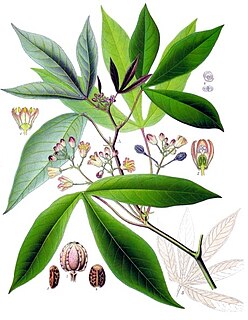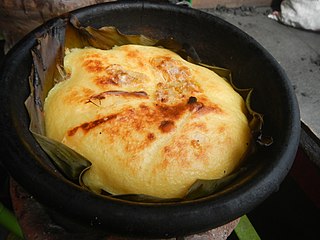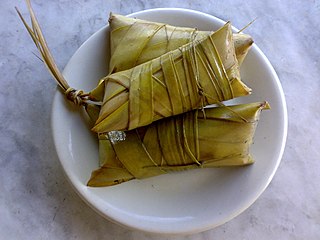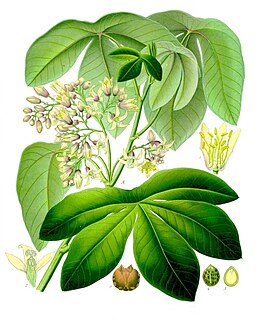
Manihot esculenta, commonly called cassava, manioc, yuca, macaxeira, mandioca, aipim, and agbeli, is a woody shrub native to South America of the spurge family, Euphorbiaceae. Although a perennial plant, cassava is extensively cultivated as an annual crop in tropical and subtropical regions for its edible starchy tuberous root, a major source of carbohydrates. Though it is often called yuca in parts of Spanish America and in the United States, it is not related to yucca, a shrub in the family Asparagaceae. Cassava is predominantly consumed in boiled form, but substantial quantities are used to extract cassava starch, called tapioca, which is used for food, animal feed, and industrial purposes. The Brazilian farinha, and the related garri of West Africa, is an edible coarse flour obtained by grating cassava roots, pressing moisture off the obtained grated pulp, and finally drying it.

Tapioca is a starch extracted from the storage roots of the cassava plant, a species native to the north region central-west region of Brazil, and certain parts of West Africa but whose use is now spread throughout South America. The plant was brought by the Portuguese to much of West Indies, Africa and Asia. It is a perennial shrub adapted to the hot conditions of tropical lowlands. Cassava copes better with poor soils than many other food plants.

Fufu is a Twi word meaning "mash or mix" for a soft doughy and swallow food staple of the Akan ethnic groups in Ghana. While native to Ghana, fufu now commonly features in many countries in West Africa and Central Africa such as Ghana, Sierra Leone, Guinea, Liberia, Cote D'Ivoire, Benin, Togo, Nigeria, both Congos, Cameroon, the Central African Republic and Gabon, and is also found in the Caribbean. It is often made in the traditional Ghanaian, Nigerian and Cuban method of separately mixing and pounding equal portions of cassava and green plantain flour with water. It is then adjusted to either increase or decrease the viscosity of the fufu based on personal preferences. Other flours, such as semolina, maize flour or mashed plantains may take the place of cassava flour. Fufu is often served with groundnut soup, palm nut soup, egusi soup, abunuabunu or light soup. Fufu is eaten with the fingers, and a small ball of it can be dipped into an accompanying soup or sauce.

Bibingka is a type of baked rice cake from the Philippines. It is usually eaten for breakfast, especially during the Christmas season. It is traditionally cooked in clay pots lined with leaves. It is a subtype of kakanin in Philippine cuisine. Bibingka is also found in East Timor and Christian communities in eastern Indonesia.

The cuisine of the Democratic Republic of the Congo and the Republic of the Congo varies widely, representing the food of indigenous people. Cassava, fufu, rice, plantain and potatoes are generally the staple foods eaten with other side dishes.

Tapai, is a traditional fermented preparation of rice or other starchy foods, and is found throughout much of Southeast Asia, especially in Austronesian cultures, and parts of East Asia. It refers to both the alcoholic paste and the alcoholic beverage derived from it. It has a sweet or sour taste and can be eaten as is, as ingredients for traditional recipes, or fermented further to make rice wine. Tapai is traditionally made with white rice or glutinous rice, but can also be made from a variety of carbohydrate sources, including cassava and potatoes. Fermentation is performed by a variety of moulds including Aspergillus oryzae, Rhizopus oryzae, Amylomyces rouxii or Mucor species, and yeasts including Saccharomyces cerevisiae, and Saccharomycopsis fibuliger, Endomycopsis burtonii and others, along with bacteria.

Linamarin is a cyanogenic glucoside found in the leaves and roots of plants such as cassava, lima beans, and flax. It is a glucoside of acetone cyanohydrin. Upon exposure to enzymes and gut flora in the human intestine, linamarin and its methylated relative lotaustralin can decompose to the toxic chemical hydrogen cyanide; hence food uses of plants that contain significant quantities of linamarin require extensive preparation and detoxification. Ingested and absorbed linamarin is rapidly excreted in the urine and the glucoside itself does not appear to be acutely toxic. Consumption of cassava products with low levels of linamarin is widespread in the low-land tropics. Ingestion of food prepared from insufficiently processed cassava roots with high linamarin levels has been associated with dietary toxicity, particularly with the upper motor neuron disease known as konzo to the African populations in which it was first described by Trolli and later through the research network initiated by Hans Rosling. However, the toxicity is believed to be induced by ingestion of acetone cyanohydrin, the breakdown product of linamarin. Dietary exposure to linamarin has also been reported as a risk factor in developing glucose intolerance and diabetes, although studies in experimental animals have been inconsistent in reproducing this effect and may indicate that the primary effect is in aggravating existing conditions rather than inducing diabetes on its own.
Phytophthora drechsleri is a plant pathogen with many hosts.

Rosellinia necatrix is a fungal plant pathogen infecting several hosts including apples, apricots, avocados, cassava, strawberries, pears, hop. citruses and Narcissus, causing white root rot.
Phyllosticta manihotis is a plant pathogen originating from the Philippines that forms on the leaves of several cassava species like Manihot dichotoma, M. glaziovii and M. heterophylla.
Mycosphaerella henningsii is a fungal plant pathogen that causes Brown leaf spot (BLS) in cassava).Part
Phaeoramularia manihotis is a fungal plant pathogen infecting cassava.

Suman is a rice cake originating in the Philippines. It is made from glutinous rice cooked in coconut milk, often wrapped in banana leaves, coconut leaves, or buli or buri palm (Corypha) leaves for steaming. It is usually eaten sprinkled with sugar or laden with latik. Suman is also known as budbud in the Visayan languages that dominate the central half of the country. A widespread variant of suman uses cassava instead of glutinous rice.
A great variety of cassava-based dishes are consumed in the regions where cassava is cultivated, and they include many national or ethnic specialities.

Daun ubi tumbuk is a vegetable dish commonly found in Indonesia, made from pounded cassava leaves. In Indonesian, daun means leaf, ubi refers to cassava, and tumbuk means pounded. The cassava leaves are traditionally pounded with a wooden mortar and pestle, although finely chopping or puréeing them using a blender or food processor is an alternative.
Parakari is a fermented alcoholic beverage made by Amerindians of Guyana. Like other cassava alcoholic beverages, parakari is made by dual fermenting cassava, which involves the use of an amylolytic mold by chewing it.

Manihot carthaginensis subsp. glaziovii, also known as Manihot glaziovii, the tree cassava or Ceara rubber tree, is a species of deciduous flowering plant in the spurge family, Euphorbiaceae, that is native to eastern Brazil.

Cassava cake is a traditional Filipino moist cake made from grated cassava, coconut milk, and condensed milk with a custard layer on top. It is a very popular dish in the Philippines, where it is commonly eaten for merienda. It is also served during gatherings and special occasions.
Kabkab, also known as cassava cracker or cassava crisp, is a traditional Filipino disc-shaped wafer made from ground cassava. It originates from the southern Philippines, but is most closely associated with the cuisine of Mindanao and the southern Visayas Islands.











